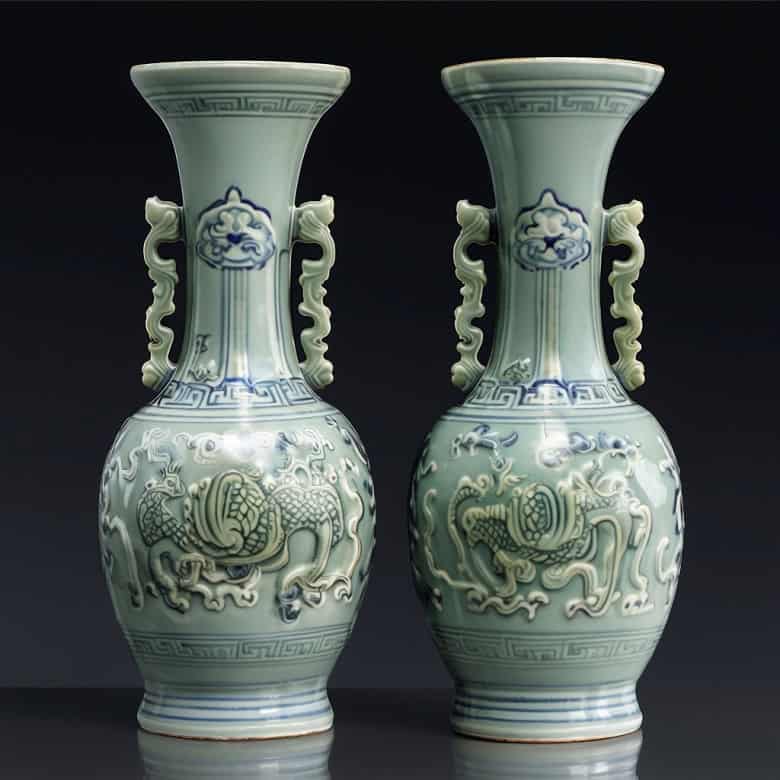Physical Address
304 North Cardinal St.
Dorchester Center, MA 02124
Physical Address
304 North Cardinal St.
Dorchester Center, MA 02124

Chinese porcelain has always been a symbol of elegance and craftsmanship, admired worldwide for its beauty and fine details. Among the many types of Chinese porcelain, the 18th-century blue and celadon vases with Kylin handles stand out for their unique design and cultural significance. These vases are not only beautiful works of art but also hold a rich history that reflects the values and beliefs of ancient China.
Porcelain has been a significant part of Chinese culture for centuries. The Chinese mastered the art of porcelain-making during the Tang Dynasty (618–907 AD), and by the time of the Qing Dynasty (1644–1912 AD), Chinese porcelain was highly sought after around the world. The 18th century, particularly during the reign of Emperor Qianlong (1736–1795), is considered the golden age of Chinese porcelain. During this time, craftsmen created some of the most exquisite and detailed works, including the famous blue and celadon vases with Kylin handles.
Celadon refers to a type of ceramic glaze that has a soft, greenish color, resembling the color of jade. This glaze was first developed during the Song Dynasty (960–1279 AD) and became one of the most popular glazes in Chinese pottery. The color is achieved by controlling the amount of iron oxide in the glaze and firing it at a specific temperature. The result is a smooth, glossy finish that is both elegant and durable.
In addition to celadon, blue glaze was another popular color used in Chinese porcelain. The blue color was usually achieved using cobalt oxide, which turned a vibrant blue when fired at high temperatures. This deep blue color was especially prized in Chinese art, symbolizing the sky and the ocean, both of which held great importance in Chinese culture. The combination of blue and celadon in a single piece of porcelain made these vases particularly valuable and sought after.
One of the most distinctive features of these vases is the presence of Kylin handles. The Kylin, also spelled Qilin, is a mythical creature in Chinese culture, often depicted as a combination of a dragon, horse, and various other animals. It is considered a symbol of good luck, prosperity, and protection. The use of Kylin imagery in art and architecture was common during the Qing Dynasty, and it was believed that these creatures had the power to ward off evil spirits and bring good fortune to those who possessed them.
The design of these vases is a testament to the skill and creativity of Chinese artisans. The vases are typically tall and slender, with a wide base that tapers into a narrow neck. The body of the vase is often adorned with intricate patterns, including floral motifs, landscapes, and scenes from Chinese mythology. The combination of the blue and celadon glazes creates a striking contrast, highlighting the delicate details of the design.
The most notable feature of these vases is the Kylin handles. These handles are usually sculpted to resemble the head or full body of a Kylin, with meticulous attention to detail. The Kylin handles not only serve a practical purpose but also add to the aesthetic appeal of the vase, making it a true work of art.
Every element of these vases has symbolic meaning. The blue color represents the heavens and divine power, while the celadon glaze symbolizes purity and longevity. The Kylin handles, as mentioned earlier, are symbols of good fortune and protection. Together, these elements create a piece of art that is not only beautiful but also rich in cultural significance.
In 18th-century China, owning such a vase was a sign of wealth and status. These vases were often used in the homes of the elite, displayed in prominent places to showcase the owner’s appreciation for fine art and Chinese tradition. The vases were also used in various ceremonies and rituals, believed to bring blessings to the household.
Today, these vases are highly valued by collectors and museums around the world. They are considered rare and precious pieces of art, with some fetching millions of dollars at auctions. Museums often feature these vases in their collections to illustrate the high level of craftsmanship and artistic expression achieved during the Qing Dynasty.
For collectors, identifying an authentic 18th-century Chinese blue and celadon vase with Kylin handles is crucial. There are several factors to consider when determining the authenticity of such a piece:
The value of these vases has only increased over time, making them highly sought after by collectors. The price of an authentic 18th-century Chinese blue and celadon vase with Kylin handles can vary widely depending on its condition, provenance, and rarity. Some vases have been sold for several million dollars at auction, while others might be valued at a few thousand dollars.
These vases are valuable not only because of their age but also because of the skill and artistry required to create them. The combination of the delicate blue and celadon glazes, the detailed Kylin handles, and the rich cultural symbolism make these vases a true treasure.
The 18th-century Chinese blue and celadon vases with Kylin handles are more than just decorative items; they are a window into the rich history and culture of China. These vases reflect the skill of Chinese artisans, the importance of symbolism in Chinese art, and the values of the society in which they were created. Whether you are a collector, a history enthusiast, or simply someone who appreciates beautiful things, these vases offer a glimpse into a world where art and culture were deeply intertwined.
As time goes on, the appreciation for these masterpieces continues to grow, ensuring that they will remain cherished and admired for generations to come.